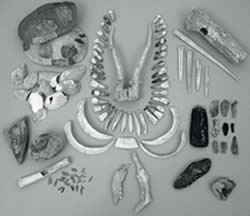Mongolian shamanka
Female Shamans and Medicine Women
In some societies that practice shamanism there is a preference for the practitioners to be female. Evidence from archaeology in the Czech Republic indicated that the earliest Upper Palaeolithic shamans were in fact women (Tedlock, 2005). Descriptions of female shamans describe these women “…as invokers, healers, herbalists, oracles and diviners, ecstatic dancers, shape-shifters, shamanic journeyers, and priestesses of the ancestors.” (Dashu, 2006). Female shamans or ‘shamankas’, are located among the Tungus people, the Buriats, Yakuts, Ostyaks, and among the Kamchadals “…the place of the shaman was usually taken by especially gifted old women.” (MacCulloch, 1918).
Altay shamanka with drum. Kharkas ethnicity, circa 1908.
In Siberia, in the steppes and central regions, the female shaman possessed greater power than the male shaman and “…in general the feminine element plays a very prominent role in sorcery among the Yakuts.2 (Maddox, 1941). Female shamans are found in Tibet and Afghanistan, with female mikogami in Japan, and an Aleut ivory statuette (1816) depicting a “…woman shaman wearing an animal mask.” (Dashu, 2006).
Female Shaman
Female shamans are dominant in some cultures where they ate to the forefront of the cult practice. Whether in ancient China or Japan, or Korea, South Africa, Okinawa, the Philippines, from northern California to southern Chile, female shamanism is a widespread tradition “…from Buryat Mongolia to the Buriti religion in Gabon, that the first shaman was a woman.” (Dashu, 2006).
Reconstruction of a Mesolithic female shaman, 7000-6500 BCE, Bad Durrenberg.
The Ekven burial of a female shaman was found at Chukotka on the Russian side of the Bering Strait. Some 2000 years old it was the grave of an elderly woman with a wooden mask at her knees as well as other ritualistic and shamanic artefacts.
The Ekven burial. Source: public domain.
Recurrent artefacts and examples of female shamanic practice are amulets, medicine bags, mirrors, and head-dresses shown by excavated regalia, as well as drums. Examples can be seen in southern Chile where female shamans of the Mapuche Nation use drums called kultran. Korean female shaman drummers use mudangs. Drumming would be accompanied by chants and invocations as is shown by the Mexican Indian shamans.
The Mesolithic interment at Bad Durrenberg occurred some 8,500 years ago. It was a woman around 25 years of age accompanied by a child of some 6 to 12 months of age. The grave goods and artefacts comprised those assumed to have a ritualistic and shamanic function.
Bad Durrenberg burial. Source: public domain.
Evidence of the primordial origin of female shamans is shown by the excavated burials. Such burials have been found dating from the 5th century before the present. These include the Priestess of Ukok ( as well as remains from south Kazakstan, and the basin from the Ukraine to the Tarim. Archaeologists have determined that these ancient female interments in central Asia were shamanic priestesses. The mummified remains of a female shaman was from the 5th century BCE, and a kurgan of the Pazyryk Culture of ancient Altai.
Mummy of the Ukok princess
Discovered and excavated in 1993 (Polosmak, 1994; 1997)) she has been dubbed the Siberian Ice Maiden. This woman is also variously known as the Princess of Ukok and the Altai Princess, or Ochy-bala after the Altai heroine.
Illustration of the Ukok shamanic burial
The burial of a female Natufian shamans discovered in a cave site at Hilazon Tachtit (in Israel) was dated to circa 12,000 BP (Grossman, 2008). The Natufians of the southern Levant of 15,000 to 11,500 BP were a nomadic people who lived along the east Mediterranean (Tharoor, 2008).
The excavated remains were those of a diminutive, disabled ‘shaman’ woman of advanced years, in a specially constructed grave. The interment represents the ritual burial of one of the oldest human spiritual figures.
The interment ritual and technique indicate a shamanic burial with especially placed animal bones, some 50 tortoise shells, the tail of a cow and the wing of an eagle. The grave suggests that the people living with and around this woman of some 45 years held her in high regard. As a shaman she would have been a mystic imbued with animist powers and revered social status.
Among north Amerindians medicine women are as common as medicine men, especially among the Dakotas and the Creeks (Maddox, 1941), with both occurring among the Inuit. As with shamans the medicine womanand the practice of healing is not restricted to members of the male gender.
North American Medicine Woman in Prayer
In ancient Greek mythology, in the temples of Argos, , the goddess Hygeia was the daughter of Aesculapius. The fact that the great Mother Goddess Hera, as Lucina, propitiated at or presided over childbirth, and that the original goddesses were probably real medicine women indicates “…in remote antiquity women were engaged in the practice of medicine.” (Maddox, 1941).
Blood Medicine woman, Calgary circa 1900.
In central Australia the medicine is ranked equal to the medicine man just as the female shaman is the equal of the shaman. Women shamans as medicine women propitiated the spirit world and practised the healing arts towards their own sex. Medicine women were thus equal to the medicine man. Not only in the way they became such but also in social status, their role and function, but in all other respects.
Medicine woman
The role of the ‘witch detective’ was often combined with that of the medicine woman and in central east Africa the medicine woman was also a witch detective and prophetess. 
Menomonee medicine woman
As has been shown by both female shamans and medicine women in many times, climes and cultures “…it not infrequently happens that the female idea of the Shamanate prevails to such an extent that the most powerful shamans are women…” (Maddox, 1941). The antiquity of the shamanic role of women is illustrated by the evidence of surviving rock and cave art which can be interpreted in terms of shamanism, fertility ritual, and rites of passage.
Rock art in southern Africa can be analysed from two approaches (Eastwood, 2005), one that incorporates women issues within a framework of shamanism, and secondly one that treats it as outside the understanding shamanism. Depictions on cave walls can be interpreted in terms of the shamanistic nature of the puberty rites of girls (Lewis-Williams, 1998; Lewis-Williams, 2004).
A distinction has to be made between the meaning of the terms ‘shamanic’ and ‘shamanistic’. The word ‘shamanic’ refers to the and practices and experiences of shamans, whereas ‘shamanistic’ refers to general beliefs and practices (Whitley, 1998). The analysis can be, and has been, extended to an interpretation of cave paintings claiming that the art was the work of women.
A recent study by Dean Stone of Pennsylvania State University produced results that “…indicated prehistoric female artists also helped create the famous ‘spotted horses’ cave mural and various others.” (daily Mail, 2009). The hand prints on the mural were dated to 25,000 BCE. Many of the hand prints were smaller than female hands as established by analysis of digital ratios.
The ‘spotted horses’ at Pech Merle, France. Source: public domain.
The evidence appears to show that a large number of Upper Palaeolithic cave artists were women confirming that the “…women’s role in prehistoric society was much greater than previously thought.” (Daily Mail, 2009). It is most likely, considering the role of women in primordial society as shamans, that ancient art was mostly the work of women (Webb, 2013).
Hand prints on cave walls were analysed by Dean Snow who showed that there was a gender difference between relative lengths of fingers. Men and women’s finger lengths are different. Even though another theory claims the hand prints may be those of adolescent boys some 75% of cave art hands are female.
Hand prints from Cueva de las Manos, Santa Cruz, Argentina
Examples of hand print art in caves have been found in southern France, in Australia, Argentina, Africa and Borneo. In northern Spain hand prints were believed to be some 40,800 years old (Subbaraman, 2013) where of 32 hand stencils 24 were female.
The hand prints from the Gargas Caves in the Pyrenees, 27,000 years ago.
Hand stencils support the theory that, not only were women actively involved in cave art, but that they were in their role of shamans leaders in ritualistic, fertility and magical practices, many of which were also linked to rites of passage for other members of the community.
References and sources consulted
Balzer, M. M. (1996). Shamanism. In: Levinson & Ember, eds.
Daiily Mail. (2009). Prehistoric Cave Paintings Made by Women as well as Men. 6.7.2009.
Dashu, M. (2006). Suppressed Histories. On web.
Eastwood, E. B. (2005). From Girls to Women: female imagery in the San Rock Paintings. Before Farming. 3 (2).
Grossman, L. et al. (2008). A 12,000-year-old Shaman burial from the southern Levant. Proc.Nat.Acad.Sci. 105 (46). USA
Hastings, J. (1918-28). Encyclopaedia of Religion and Ethics. Edinburgh.
Levinson, D. & Ember, M. eds. (1996). Encyclopaedia of Cultural Anthropology. Henry Holt, New York.
Lewis-Williams, J. D. (1998). Quanto. South African Archaeological Bulletin. 53.
Lewis-Williams, J. D. & Pearce, D. (2004). San spirituality roots. Double Storey, Cape Town.
MacCulloch, J. (1918). Shamanism. In: Hastings, J. ed.
Maddox, J. L. (1941). The Medicine Man. Yale UP.
Polosmak, N. (1994). National Geographic. October.
Polosmak, N. (1997). BBC Documentary.
Subbaraman, N. (2013). NBC News. 15.10.2013.
Tedlock, B. (2005). The Woman in a Shaman’s Body. Bantam, New York.
Tharoor, I. (2008). 12,000-tear-old Shaman Unearthed in Israel. Time, 11.11.2009.
Webb, S. (2013). Earliest artists were women. Mail Online, London.
Whitley, D. S. (1998). Cognitive neuroscience shamanism, and rock art of Native California. Anthropology of Consciousness. 9.

















Reblogged this on devils and black sheep..
Thanks, great stuff. One thing though, the two photos of hand stencils are of the same site, not from two different continents.
Dr. Silas Mallery
Thanks so much for pointing out my error and am very grateful for your comment. I will correct my mistake tomorrow. All the best, Eric Edwards.
nice work “Female Shamans and Medicine Women”
Pingback: 9,000-8500 year old Female shaman Bad Dürrenberg Germany | Damien Marie AtHope
Reblogged this on Bear Foot Connections 'Empowering the Web of Life'.
Reblogged this on Macha Shewolf.
Pingback: October blog 2015 A Full Moon Eclipse brings needed change to the world | Ellen Evert Hopman
Thank you Erik, it brings great joy to my heart when men support women’s prehistory traditions, i am a wind whisperer (slavic), you may enjoy my page and this article in particular – Baba Phoenix
https://eldermountain.wordpress.com/2015/08/22/carpathian-shaman-healing-magical-rites/
Pingback: Was the Value of Ancient Women Different? | Damien Marie AtHope
Pingback: Shamanism: an approximately 30,000-year-old belief system | Damien Marie AtHope
Pingback: Horned female shamans and Pre-satanism Devil/horned-god Worship? | Damien Marie AtHope
Pingback: Female Shamans and Medicine Women | mysticmindsblog
I’ve been painting a series of Native Americans from Edward Curtis’ work and am looking to expand my collection. I am seeking historical (noncopyrighted) images of Female Shamans and warriors (particularly Americas) for the new series. Could you share the photographer’s name for the Blood Medicine Woman image if you know it?
Pingback: Similarity in Shamanism? | Damien Marie AtHope
Pingback: Horned female shamans and Pre-satanism Devil/horned-god Worship? at least 10,000 years ago | Damien Marie AtHope
Pingback: Finland’s Horned Shaman and Pre-Horned-God at least 4,500 years ago? | Damien Marie AtHope
thank you
Pingback: Shaman burial in Israel 12,000 years ago and the Shamanism Phenomena | Damien Marie AtHope
Pingback: Women and Shamanism ~ Psy Minds
Pingback: Plant Medicine-History of Women Shaman -
This is massively helpful, thank you for this resource.